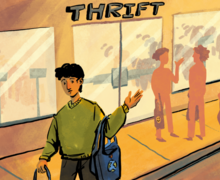Kramer: Seattle legislation hinders progress of smartphone taxi companies
Digitally-inspired taxi companies have been spreading quickly during the past five years, but this week, the services have hit a roadblock.
Overwhelmingly popular across the nation’s biggest cities, “rideshare” companies, also called Transportation Network Systems (TNCs), like Uber, Lyft and Sidecar, operate mobile apps through which customers can effectively hail a cab at the tip of their finger. Each company employs its own drivers — who drive their own cars — and manages a system where the driver will pick a customer up in a matter of minutes, guaranteed.
With Uber valued at $3.5 billion and Lyft at $700 million, according to a March 9Verge article, it’s clear that the marriage of innovative technology and the taxicab was an opportunity waiting to be explored. These and other TNCs alike are expanding to more cities as demand increases — consumers are looking for a more enjoyable and personable experience when they hitch a ride home or out to the clubs.
But rideshare companies were dealt an unfamiliar blow in Seattle on March 17 when the city council passed legislation that will prohibit any of the companies from operating more than 150 cars at a given time.
Seattle’s new regulation on these companies is a threat to their business plan. A company like Uber needs to have a glut of drivers on the road if it wants to guarantee short waiting times, especially on weekends and other nights for going out. Uber CEO Travis Kalanick told GeekWire on March 14 that the new rules could “incapacitate Uber and make it unusable.”
Those working at rideshare companies are pointing fingers at the council for corruption. Sidecar CEO Sunil Paul said in a March 18 interview with Bloomberg, “the only rationale for (the cap) is to protect the existing taxi industry.” Even Seattle city council member Tim Burgess told the Seattle Post-Intelligencer in a March 17 article that implementing the cap, “would be like prohibiting Netflix to protect Blockbuster.”
But the distinction between the two industries isn’t just about who provides better service, it’s about insurance. What happens when an Uber driver causes an accident or hurts someone?
If a TNC driver causes an accident, it is common procedure to charge the insurance company of that driver. But since Uber, Lyft and the like face no regulation regarding insurance, there’s an ongoing question: who pays, the TNC or the driver?
KQED, an affiliate of NPR, said in a Nov. 19, 2013 report that drivers might get dropped from their plans if their insurance companies find out they are transporting passengers for pay. That report also showed evidence that many Lyft and Uber drivers go to extensive lengths to hide the fact that they are an employed rideshare driver, especially in the case of an accident, out of fear that their coverage will be dropped.
So what happens if an insurance company won’t cover a Lyft or Uber driver who does cause an accident? A March 14 Seattle Times article shows that “Uber will provide contingent coverage that would pay up to $50,000 for injury to one person, $100,000 for injuries to all persons and $25,000 for property damage.” Seattle taxis, by comparison, are required to cover up to $300,000 for injury. And Uber only introduced this plan to extend coverage once talks of regulation were getting finalized.
This problem doesn’t only exist in Seattle. Ever since ridesharing became popular, many big cities, notably Chicago, Washington, D.C., San Francisco and New York, are grappling with the kind of tough decision that Seattle just made. On one side of the ring you have the innovative consumer favorite TNCs with ticky-tacky insurance plans; on the other side, the traditional taxis who don’t want to get undercut by startups dodging costs.
Is it fair that one industry gets bogged down with city regulation while the other gets off by virtue of being “new?” And even if the fine print raises questions about insurance, the Seattle council seems quite comfortable with undermining competition. Regardless of the decision, Uber & Co. won’t be letting Seattle escape — their continuing growth indicates that they may soon be stronger than any legislator can hope to contain.
Phil Kramer is a freshman advertising and marketing management major. His column appears weekly. You can reach him at pwkramer@syr.edu.
Published on March 20, 2014 at 1:12 am





